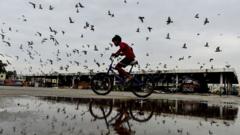In a rapidly escalating conflict over the health implications of pigeon feeding in Mumbai, a court's recent ban has ignited protests among citizens and sparked heated debates. Hundreds of demonstrators clashed with police as they gathered to oppose the closure of traditional pigeon feeding locations, known as kabutarkhanas. The ban stems from concerns around health hazards associated with pigeon droppings, a topic that has also garnered attention globally, with similar measures in cities like Venice, Singapore, and New York.
Maharashtra state, where Mumbai is located, has preceded this ban with regulations in Pune and Thane, while Delhi is contemplating its own restrictions. In the midst of this crackdown, cultural and religious sentiments are colliding with public health rhetoric, prompting strong responses from activists and members of the community, particularly from the Jain faith, who view feeding pigeons as a sacred duty.
Pigeon feeding is deeply embedded in Indian culture, often showcased in films symbolizing urban life. Yet, the aftermath of increased pigeon populations raises serious health concerns, with studies highlighting risks of pulmonary diseases due to exposure to droppings, which contain harmful pathogens. The rapid growth of the pigeon population has led experts to warn about the ecological implications and health risks posed to urban residents.
Among those affected, individuals like Syed Ismat, who has fed pigeons for over four decades, defend their practice as a moral obligation, expressing fear that the ban may lead to starvation of many birds. Others, including health advocates, cite the rise in pigeon population—150% from 2000—as a pressing concern, urging for stricter regulations.
As the Bombay High Court reinforces its stance, dismissing appeals against the feeding ban for health reasons, animal rights activists and community members continue to seek a compromise that respects public health while preserving cultural practices. Suggestions have emerged, including controlled feeding hours, to uphold both neglected health issues and the communities' emotional connections with pigeons.
As debates continue, a collaborative approach that accommodates both perspectives may be vital to reimagine urban ecosystems where humans and wildlife coexist harmoniously. With an expert panel looking into alternative measures, the dialogue surrounding this contentious issue is far from over.
Maharashtra state, where Mumbai is located, has preceded this ban with regulations in Pune and Thane, while Delhi is contemplating its own restrictions. In the midst of this crackdown, cultural and religious sentiments are colliding with public health rhetoric, prompting strong responses from activists and members of the community, particularly from the Jain faith, who view feeding pigeons as a sacred duty.
Pigeon feeding is deeply embedded in Indian culture, often showcased in films symbolizing urban life. Yet, the aftermath of increased pigeon populations raises serious health concerns, with studies highlighting risks of pulmonary diseases due to exposure to droppings, which contain harmful pathogens. The rapid growth of the pigeon population has led experts to warn about the ecological implications and health risks posed to urban residents.
Among those affected, individuals like Syed Ismat, who has fed pigeons for over four decades, defend their practice as a moral obligation, expressing fear that the ban may lead to starvation of many birds. Others, including health advocates, cite the rise in pigeon population—150% from 2000—as a pressing concern, urging for stricter regulations.
As the Bombay High Court reinforces its stance, dismissing appeals against the feeding ban for health reasons, animal rights activists and community members continue to seek a compromise that respects public health while preserving cultural practices. Suggestions have emerged, including controlled feeding hours, to uphold both neglected health issues and the communities' emotional connections with pigeons.
As debates continue, a collaborative approach that accommodates both perspectives may be vital to reimagine urban ecosystems where humans and wildlife coexist harmoniously. With an expert panel looking into alternative measures, the dialogue surrounding this contentious issue is far from over.





















